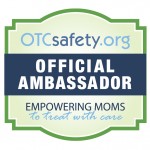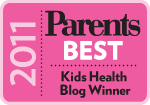 When Alice from Science of Mom: The Heart and Science of Parenting (I love that, don’t you?) asked me to answer a few questions on the topic of infant sleep, SIDS, and bed-sharing as part of research for the sleep chapter of a parenting book she’s writing (which I can’t wait to read by the way), I was initially very eager. After all, this is a major topic. One parents ask me about all the time. And one in which safety is always at the forefront when I’m talking to families about it.
When Alice from Science of Mom: The Heart and Science of Parenting (I love that, don’t you?) asked me to answer a few questions on the topic of infant sleep, SIDS, and bed-sharing as part of research for the sleep chapter of a parenting book she’s writing (which I can’t wait to read by the way), I was initially very eager. After all, this is a major topic. One parents ask me about all the time. And one in which safety is always at the forefront when I’m talking to families about it.
But then…I wasn’t so eager.
When I looked at the questions, I became a bit deflated. Not because they aren’t great questions. They are. But because I realized my answers were not coming easy. What I wanted to say was complex and various shades of gray. And when it comes to sleep and safety in babies…don’t we all want easy, straight, and simple recommendations? Something we can apply universally to all babies and families?
I sat on these questions for a long…long time. Sorry, Alice.
And then this study was just released. And oh boy, the media is giving it a great run: Bed-sharing found to increase risk of SIDS five-fold. Wow. Wait…what? That is striking, isn’t it?
It got me thinking again and made me realize I can no longer just stop talking and thinking about these questions. They are vitally important. This study is important. We need to analyze what valuable information it actually does give us and also, the important information it does not.
So, I finally sat down with these questions yesterday…and you know what? The answers finally came easy. Not because they’re simple answers. But because they’re complex. Complex, important, and absolutely necessary to talk about.
1. How did sleep look for your two children?
My first child was a challenge to say the least. He is the one who made me question the safety of bed-sharing in the first place. For the first 6 months of his life, sleep was virtually non existent (or at least that’s the way it felt to me) because he needed my arms and constant soothing throughout the night. But I was terrified to bedshare. I was literally at the end of my sleep deprivation rope. I had tried everything. And instead of listening to my instincts, I was fighting them. Because I was scared.
I never envisioned myself as a bedsharing parent. As a pediatrician, I was adamantly against it. But it was exactly what my baby needed and we struggled and limped along until I finally realized that.
My second child was a breeze and that’s no lie. She was always (and still is) an “easy sleeper”. She needed her space and showed clear signs of being tired. When she was tired, that was it. I didn’t need to bedshare with her. She slept in her own bassinet next to our bed during her first few months of life before being transitioned to her own room.
They could not have been more different in the sleep department. Same parents. Same environment. Different children.
2. As a pediatrician, how did you feel about bedsharing before having children? Did becoming a mother change that?
I didn’t think it was safe. At all. I had read the studies and the official recommendations. Back to sleep, crib and/or bassinet in the same room with no hazards such as loose bedding, pillows, etc.
I never thought in a million years I would have become a bedsharing parent. But kids don’t have our same agendas. They don’t read the books or the studies. And when it comes to sleep…nothing could be more variable. The only constant is that we all need it.
3. You’ve written on your blog about your decision to finally bedshare with your first child. What kind of responses did your receive from other pediatricians and parents to your posts?
Most reactions have been…yeah, I’ve been there. Or…I had a baby like that too. But, I’ve received some criticism too. Honestly, I think it happens to more families than are willing to admit it. It’s still taboo, particularly in the medical field. With good reason, for sure; but I think we need to talk about it. We need to address the issue. Not simply say…don’t do it, it’s not safe.
This is not a one size fits all situation. There are so many factors at play. So from a practical standpoint, we need to be willing to hear parents out and meet them where they are.
4. Do you believe that bedsharing can be safe if practiced with care?
I think it can be made “safer”. I still believe that the AAP recommendations against it and safe sleeping tips such as back to sleep, sleeping in a separate crib or bassinet but in the same room as parents, and the guidelines for keeping loose bedding, etc out of baby’s crib is the safety gold standard.
BUT…there are thousands of families who choose to bedshare and are committed to it. They will continue to do so in spite of recommendations against it. As a pediatrician and first time mom, I found myself at this very crossroad. For me, bedsharing was born out of sheer need…and a nagging instinct that I had been fighting. Still, it took me 6 months to finally feel good about doing it.
For bedsharing families I think we have a responsibility to discuss safety issues with them. We need to advise them the safest way to do so. There are so many variables involved when it comes to bedsharing that makes studying it and having safe bedsharing guidelines difficult from a public health perspective. That alone makes it inherently risky.
But it doesn’t mean that we shouldn’t try. We absolutely should. Removing some of the added risks that can go along with bedsharing (such as heavy blankets, other children, exposure to second-hand smoke etc.) will reduce the risk of SIDS and accidental suffocation. So we should be having these discussions.
We know that bedsharing can look very different from one family to the next. It can be absolutely dangerous for one infant but relatively safe for another. One thing parents should know is that bedsharing cannot be an afterthought nor an act of desperation…this is very dangerous. Safe bedsharing is really an overhaul of the whole sleep environment. You cannot simply take your baby and put him/her in your bed without any preparation. So parents really have to be committed to it and be willing to take the proper safety precautions.
Alternatively, exhausted parents who are too frightened to bedshare may fall asleep holding their babies in their arms on couches, chairs, or in their beds. You can imagine how dangerous that can be for an infant. Before I embarked on bedsharing, I found myself in these very situations.
5. The AAP recommends against bedsharing in their policy statement on prevention of SIDS/suffocation deaths. Do you think this recommendation is appropriate? Do you share the AAP recommendation with the families in your practice?
Yes and I do share these recommendations with my families. But I also ask them what sleep looks like in their house. How is everyone sleeping? Where do they sleep? Does anyone smoke? Where do they want baby to sleep and have they taken the proper precautions to make sure baby’s sleep environment is as safe as possible?
This allows for a more open, honest, and insightful discussion on what’s really going on in the home instead of simply spouting off the way they should be doing things.
6. Do you find it difficult to reconcile the realities of infant sleep practices among your patients with the AAP’s recommendation? Do you feel that the AAP’s stance against bedsharing puts you in a tight place?
Sometimes an awkward place, yes. I agree with the AAP but I don’t think it sheds light on the whole story. Families are dynamic, babies are ever changing and no two are alike. There is no possible way to control for all the factors involved here. But we should be able to come up with universal safe sleep guidelines for ALL babies, not just the ones sleeping in cribs or bassinets.
7. Do you believe that bedsharing can be beneficial to babies and families? Are there disadvantages to bedsharing that you think parents should be aware of?
Yes. If it works for the families and babies seem to be thriving, absolutely. But parents need to be happy with it, not resenting every second of it. Breastfeeding moms tell me how wonderful it is and that they get more sleep that way.
The disadvantages are the inherent risk factors. I really stress to parents that bedsharing is a sleep overhaul for everyone. In order to make it the safest possible and eliminate some of these added risks they need to be willing to make some dramatic changes in their own sleep environment since baby will be there with them.
Here’s what “safe bedsharing” looks like to me:
- a firm mattress on the floor as the sleeping surface (eliminates fall and entrapment risks)
- baby sleeps between mom and edge of bed without anyone else in the bed (no pets, siblings, or dad…I know, sorry)
- no maternal smoking, alcohol, or sedating medications
- no loose bedding or comforters
- baby is always put on his/her back to sleep
- ideally, this is a breastfeeding baby and if parents can put off bedsharing until 4 months of age when the risk of SIDS goes way down that is ideal too.
9. Is there anything else you’d like to share about your experiences with infant sleep as a pediatrician or as a parent yourself?
We need to remember that it’s not one size fits all. We really need to take into consideration each unique baby and the sleep needs of both the parents and the baby. However, safety should always be paramount and this is where things become murky. The evidence that we have so far is stacked against bedsharing (but again, I think there are just too many factors to control for). I don’t think we’ll ever get the sleep studies that we want or need.
So the bottom line for me is: stick to the AAP sleep recommendations. Bedside bassinets are great for proximity and ease of breastfeeding. However, if you find yourself (like me) with a baby who needed constant contact and/or you are committed to bedsharing, make sure you take the necessary precautions. Know the risks and know what you can do to minimize them.
And this is where we (as pediatricians and public health advocates) can really help these families. We need to be willing to discuss the issues surrounding bedsharing beyond the standard it’s not safe, so don’t do it. A chronically sleep deprived mom and/or parent is dangerous for babies too. I think we can really have a positive impact on all babies by addressing these particular safety issues head on. After all, we are working towards the same goal…bringing up healthy and happy babies.
Pin It








Very interesting questions raised here. I noticed that Melissa was fighting a NATURAL instinct to be near her baby…I felt that same fight within me when my first son was born. Is it alarming that the AAP uses flawed studies to strongly recommend against a natural human behavior? I looked back on the sleep struggles with my first born and realized that all the “issues” stemmed from me following all the advice from the medical community about how to raise my baby and ignoring the instincts inside of me. I am thankful for doctors like Melissa who think for themselves and applaud her for not blindly following AAP recommendations!!
Melissa– great nuanced discussion of a difficult topic. For me this is a topic I have struggled with professionally. It was not an issue for our children because they really never slept well in our bed even when we wanted them to.
We bedshare. My first mostly slept in his own room, mostly. My second had to be next to me and my third will sleep alone but often ends up with me.
I breastfed all of them, don’t smoke, and don’t mind being cold – I throw off the big comforter.
It got to the point with the second child that I was more dangerous because I was sleep deprived. I had to sleep. Once I got sleep, I was a better mom. I honestly feared that I was so tired I would fall asleep in a dangerous way – driving, with the baby in my arms.
I think educating parents about bedsharing is what needs to happen. Thanks for the honest post.
So interesting to read this perspective from a doctor’s point of view.
We coslept with our first child because that is the only way she would sleep. Another thing to consider are the risks associated with sleep deprivation that are concerns of safety as well.
My first daughter absolutely couldn’t sleep both for naps and naptime without physical contact from me. Believe me, we tried and I was against cosleeping before being a mother. She is now grown into a 5 1/2 year old girl who is an amazing sleeper.
There absolutely needs to be more research on sleep issues for newborns. I got so much skepticism from medical professionals because they didn’t believe a newborn could have separation anxiety. But she did and I think cosleeping was one of the best things we gave to her as a baby.
Melissa – very insightful, thoughtful post. Thank you for providing all the sides of a controversial topic, and reinforcing that it’s up to parents to decide what is best for their own children and then practice it in a healthy, safe manner.
Thanks, Dr. Arca, for a well-written and much needed post. 16 years ago my nephew died of SIDS while sleeping in an adult bed. He was breastfed and his parents had not taken any medications, alcohol, or recreational drugs.
Despite consistent data that bed sharing is dangerous, there are still so many that advocate for bed sharing.
Thanks for joining the cause.
This is a refreshing view from an md to read on bed sharing, and I had a very similar experience with my 2 children. My first benefitted immensely from bed sharing, and being a new mom with narcolepsy, I felt that the extra sleep I got once I gave in to what felt natural, bed sharing, was safer than falling asleep inadvertently when holding the baby and nursing or sitting. I wasn’t sure if it was my sleep issues that led me to bed share with my first or not. And my experience with my second has proven that not every child needs to bed share as she just doesn’t need it and is sleeping well in a bassinet.